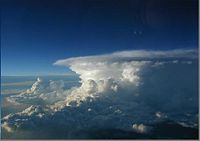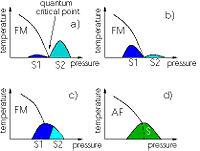Nucleation, droplets, and the physics of clouds
Nucleation is the process which results in the formation of a particle (or nuclei) of a different thermodynamic phase from a solution, liquid, or vapor. This process is very important, as almost every first-order phase transition proceeds from nucleation. Some second order processes, such as ferromagnetic reorientation and crystallization, are also caused by nucleation. There will be some basic equations and definitions for second-order nucleation, but since the physics of clouds deals with first order phase transitions (namely condensation), most of this project will be devoted to nucleation in first order phase transitions. This process occurs all throughout science and nature and has several applications, both harmless and dangerous, from the delicate formation of clouds to the explosion caused by placing Mentos in Coke. Nucleation is also very important in the development of semiconductors. In nature this process occurs at an interface, such as the surface of a container which holds the fluid or the surface of a particle of dust which is in the solution. This is referred to as heterogeneous nucleation and happens much more often than homogeneous nucleation, which occurs in completely pure liquids. This type of nucleation requires activation by supercooling or superheating the fluid. If this nucleus is the appropriate size, after nucleation the nucleus (or droplet in clouds) will continue to grow. This process is referred to as nucleation and growth, which is very important when describing precipitation in clouds.
{{#ev:youtube|g4kBNBEJKD8}} A more dangerous application of nucleation!
Phase Transitions
Before defining nucleation in more detail, it is necessary to start by stating some basic principles in thermodynamics and phase transitions. There are two orders of phase transitions. First order transitions refer to discontinuous jumps in phase transitions, such as condensation and freezing. Second-order transitions are more complicated and are described as continuous transitions. Ferromagnets, superconductors, and supercritical fluids all result from second order phase transitions.
Also, there are two states of matter, that which is in equilibrium and that which is not. The second law of thermodynamics tells us that the entropy of an isolated system not in equilibrium will tend to increase over time, approaching a maximum value at equilibrium. This explains why matter self-assembles, or re-arranges itself in the most energy efficient form. After a phase transition one can find a system which is in non-equilibrium, and it will immediately begin to re-assemble. By changing parameters of the system (such as temperature, pressure, and volume) we can force the matter into the coexistence dome, the region in which more then one phase of the same matter can exist at the same time.
Nucleation Definition & Derivation




